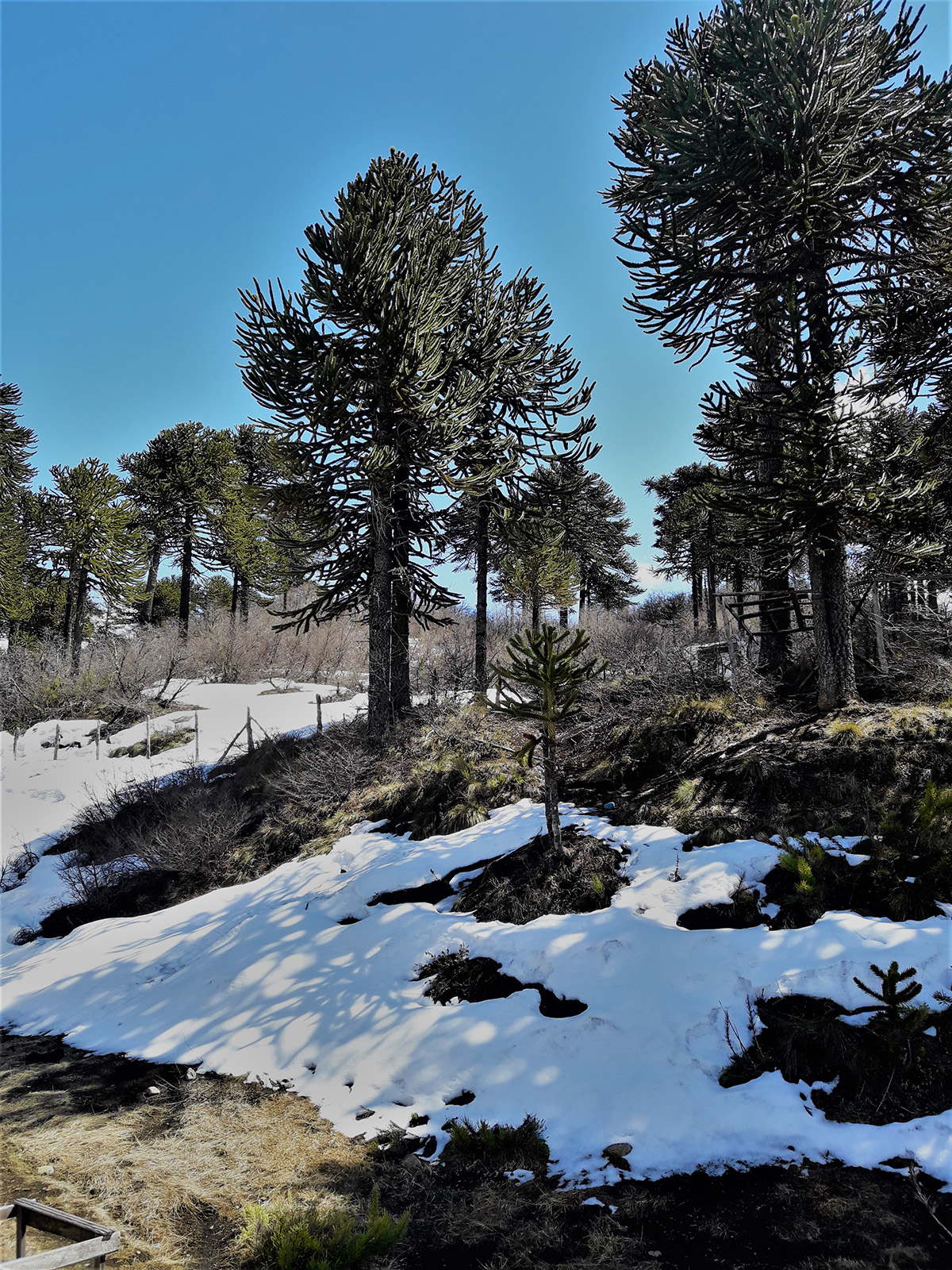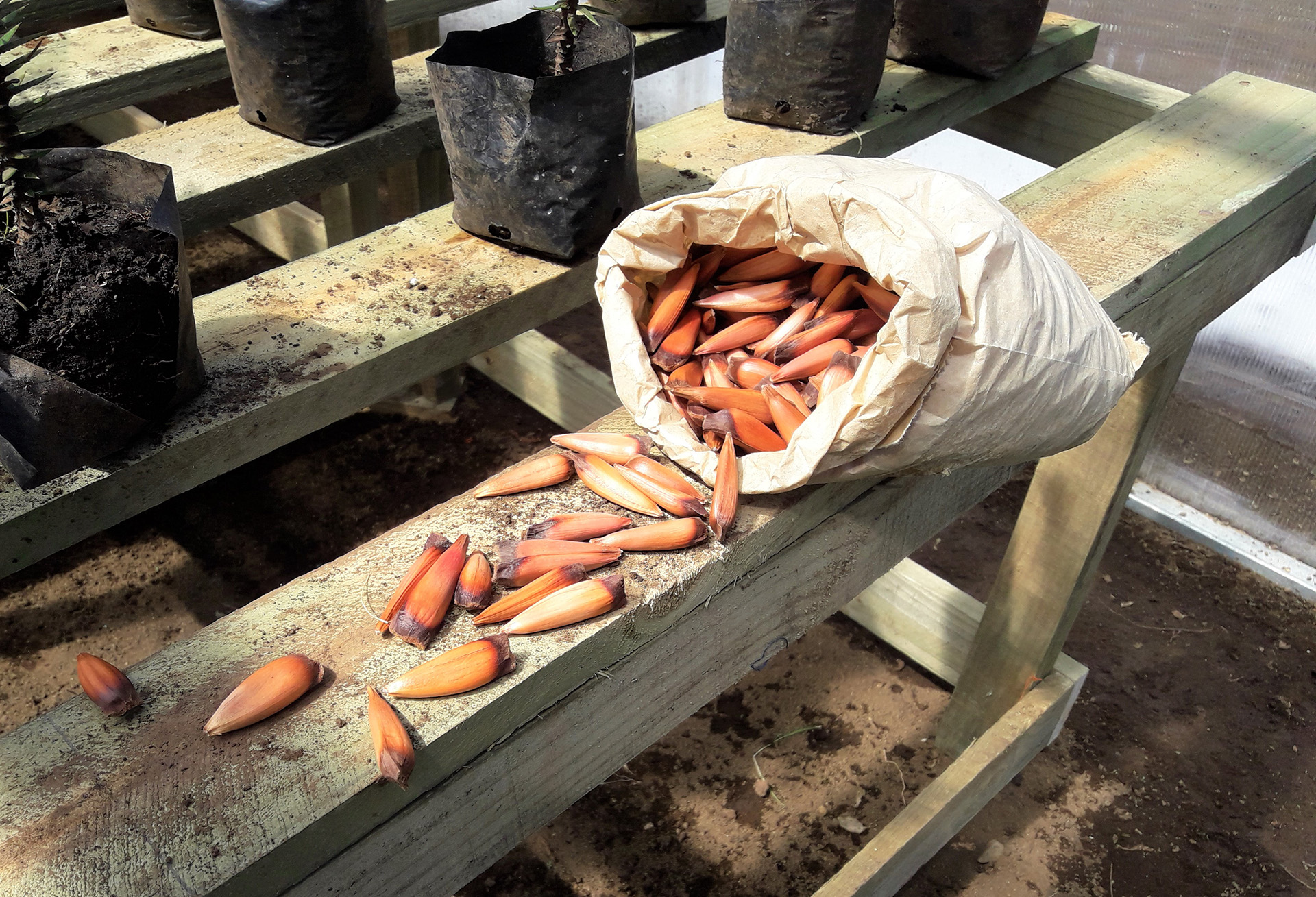This article was first published in Spanish in the magazine Indualimentos in 2019.
In La Araucanía, more specifically in the Mapuche Community of Quinquén, which is a beneficiary of Chile’s National UN-REDD Programme, efforts are made to revalue and rescue ancient ancestral practices to cultivate pine nuts.
Every day, Alexandra Martínez, teaches environmental studies to her students at the Quinquén Indigenous Community School nursery in La Araucania. There, they plant pine nuts and take care of the small araucaria plants.
The school that Alexandra heads is one of the beneficiaries of the National Strategy for Climate Change and Vegetable Resources (Estrategia Nacional de Cambio Climático y Recursos Vegetacionales or ENCCRV). This strategy was developed by CONAF as the focal point of the UN-REDD Programme in Chile, a partnership between the United Nations Development Programme (UNDP), the United Nations Food and Agriculture Organization (FAO) and the United Nations Environmental Programme (UNEP).
The indigenous community of Quinquén is home to 52 families who are part of the Mapuche-Pehuenche ethnic group and who live and subsist on the araucaria, coihue and lenga trees of their native forest.
"For us, the UN-REDD project, which is being developed by CONAF together with the United Nations, is very important because they have given us a place to plant new plants, which will allow us to reforest; and also to grow the vegetables that we need so that the children in our little school can be fed," the teacher says enthusiastically.
Rescuing ancestral knowledge
In La Araucanía, efforts are also being made to revalue and rescue ancient ancestral practices around the cultivation of pine nuts. The araucaria tree can live more than 1,000 years, reaching heights of more than 50 meters. The felling and harvesting of pine nuts and seeds from the araucaria is protected by law and is the main source of food and income for these communities, who harvest the seeds to make flour and other products.
Ricardo Meliñir is the Lonco, or traditional chief, of the Quinquén community. ”The araucaria is an important part of the Quinquén community, as working with pine nuts and seeds is something we have been doing forever, and it not only benefits us, but all people."
Today in Chile there are 17 million hectares of forest of which 14.6 million hectares are native forest. Those 17 million hectares generate the absorption of 60% of the CO2 emissions that Chile generates, thanks to photosynthesis.
“The Pehuenche way of life is interwoven with the araucaria," says José Manuel Rebolledo, Executive Director of the UN-REDD Programme in Chile. ONAF, in addition to having the responsibility of promoting the development and care of forests, works to repopulate territories that once had forests and to re-establish what naturally existed there. This is where the work done with the UN-REDD programme comes in. Its Executive Director, José Manuel Rebolledo, stresses the importance of the work that the Ministry of Agriculture is doing, through CONAF, since it has a deep sense, rooted in the Indigenous Communities of Chile.
"We are connecting and working together with the Pehuenche people, not only at the level of their traditional practices, but we are also respecting and protecting their connection with nature through programs that protect ancestral trees and other forest areas.”
As part of ENCCRV, CONAF has established a nursery in Curacautín, exclusively dedicated to the production of native species. Around 600,000 plants are produced per year, with a predominance of araucaria, oak, raulí, coihue, cinnamon, hazelnut and mañío.

"Thanks to the contribution of the UN-REDD Programme, we can count on an automated irrigation system and a nursery with a capacity for 12 thousand plants of different species. This also means we hire local labor to provide the management required for a nursery like this," says Rebolledo.
For the FAO representative in Chile, Eve Crowley, one of the most important aspects of the project is that "when the seeds are cultivated, it is done directly by people from this community. This also ensures a very important source of income for people in these rural areas."
Crowley said local women play a very important role not only in harvesting and selling the pine nuts, but also in making traditional recipes with them that favor the healthy diet of the community.
Recently an agreement was signed between CONAF and the Community of Quinquén, with the participation of Antonio Walker (Minister of Agriculture), Claudia Mojica (UNDP Resident Representative) and Eve Crowley ( FAO Representative in Chile) together with José Manuel Rebolledo (Executive Director of CONAF). The agreement includes an amount equivalent to USD 96,000 to be deliverd by UNDP to the community, to also start a project of compensation for environmental services.
Compensation for environmental services
In addition to carrying out actions to recover, restore and conserve the native forest, CONAF, through the ENCCRV, recently implemented another project that offers payment for environmental services.This project, called Adaptation actions to reduce the socio-environmental vulnerability of the indigenous community of Quinquén to the impacts of climate change, is a collaboration between CONAF and the community of Quinquén and includes funding of $96,000 US from the UNDP to the community to start a project of compensation for environmental services.
The project seeks to revalue the ancestral use of the pine nut in order to promote sustainable management of the resource and its replanting in priority sites in the territory, with a goal to improve environmental services in the area, such as water quality and tourism, while advancing a model that can be implemented in other areas.
"When one sees how the children of the Quinquén school are being trained, one understands the importance of reforesting and conserving the country's forests,” says Minister of Agriculture, Antonio Walker. “At the same time, we also have to carry out regenerative agriculture to maintain soils that are high in carbon and organic matter to mitigate the effects of climate change.”

Community action
A second project, formulated with participation from members of the Quinquén community, was created to build adapta
bility to climate change and to combat its negative effects on the territory. "With this project, we are looking to work on the sustainable management of the pine nut," says Julio Figueroa, Director of CONAF La Araucanía.
This is the second project in Chile to include payments for environmental services, and together with resuming the sustainable, ancestral and cultural management of the pine nut, it will generate tools and skills in the community. Lonco Meliñir values the fact that the communities themselves are the administrators of the environmental fund.
Lonco Meliñir values the fact that the communities themselves are the administrators of the environmental fund.
Back at the Quinquén Indigenous Community School, Martínez continues to take advantage of the training and other activities CONAF is conducting, and while she learns and teaches her students about the Araucaria, she remains hopeful that more new activities will come to their community in the future thanks to this project.



